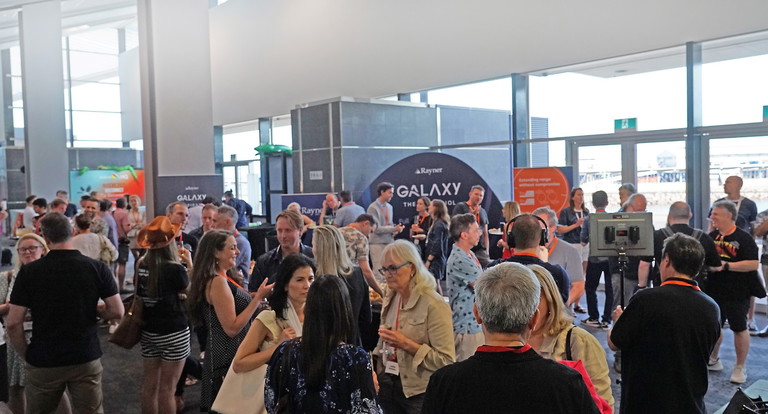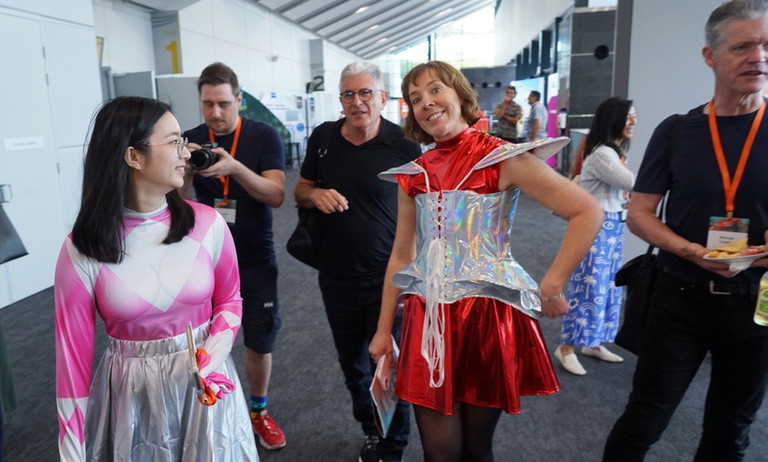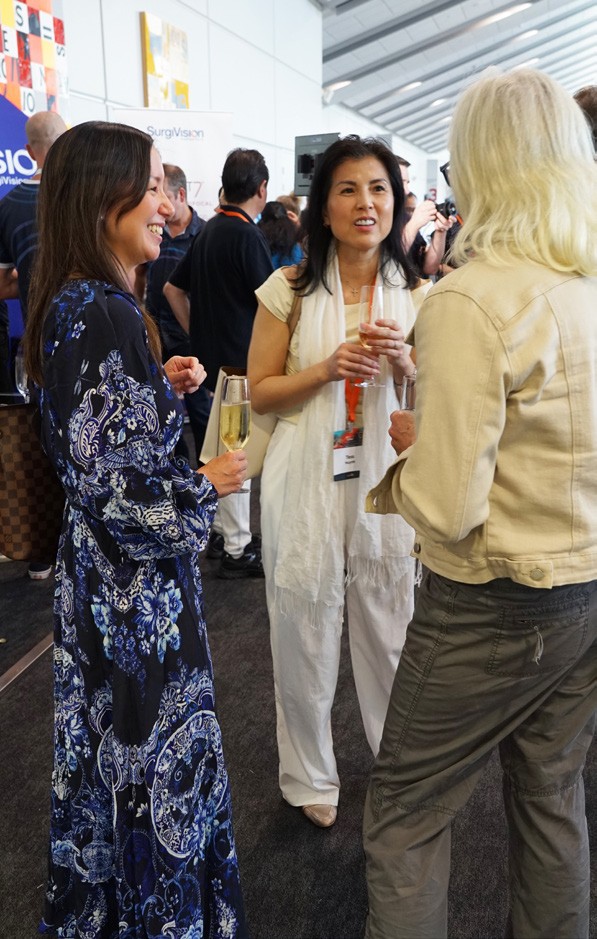mievent

Surgeons Share Clinical Insights
on Rayner Innovation at AUSCRS
WRITER Melanie Kell
The tropical setting of Darwin provided the backdrop for an engaging evening at the Rayner hospitality suite during the Australian Society of Cataract and Refractive Surgeons (AUSCRS) annual meeting. Dr Ben LaHood, the Adelaide-based eye surgeon who has earned recognition on The Ophthalmologist Power List in both 2023 and 2024, hosted a series of candid discussions with leading ophthalmologists about their clinical experiences with the RayOne EMV (enhanced monovision) and the RayOne Galaxy Spiral intraocular lens (IOL) technologies. This article highlights key points made.
The RayOne EMV IOL has established itself as a significant advancement in extended depth of focus (EDOF) technology. Designed to provide patients with enhanced visual acuity across distance and intermediate ranges, it can also provide functional near vision when used with a monovision approach.
When speaking with Dr LaHood, Dr David Gunn (Brisbane) drew from his extensive experience to provide valuable insights into the EMV’s clinical applications. He particularly values the lens for monovision strategies, explaining that “the great thing about the EMV versus a lot of other EDOF lenses is that you really get that great uncorrected distance vision in the dominant eye”.
He explained that his approach leverages the EMV’s extended depth of focus capabilities while maintaining the patient’s natural binocular visual system. Dr Gunn noted that with the availability of newer technologies like the Galaxy, he finds himself “reaching more and more for a multifocal”, though the EMV remains a valuable option for many patients. He recently had his EMV outcomes published in a peer-reviewed journal, showcasing the excellent patient outcomes with this lens.1
Dr David Lockington, President of the United Kingdom and Ireland Society of Cataract and Refractive Surgeons, offered his clinical evidence of the EMV’s success. He reported that approximately 90% of his private patients receive the EMV with excellent satisfaction rates. His monovision strategy targets the dominant eye for distance and the second eye for minus 1.25D, an approach he said has consistently yielded positive patient outcomes.
The discussion revealed the EMV’s strength in addressing night vision concerns. Dr Lockington explained that until now his biggest challenge had been “when patients come into me and say I can’t drive at night”, noting that unlike some presbyopia-correcting options, this “hasn’t been my experience with the EMV”.
Dr Lisa Nijm, a Chicago-based ophthalmologist and CEO of Real World Ophthalmology, emphasised the EMV’s clinical value, describing it as “a valuable addition to the available tools in the US”. Echoing Dr Lockington’s perspective on achieving “a nice blend of mini monovision”, she noted that her approach typically incorporates “a slight minus in the non-dominant eye”.
“This strategy allows patients to achieve a greater depth of focus and improved vision across a wider range of distances,” she explained.
SPIRAL OPTICS AND CLINICAL INNOVATION
The introduction of the RayOne Galaxy Spiral IOL has generated considerable excitement within the ophthalmic community, representing a fundamental shift from traditional diffractive designs towards refractive spiral optics technology. This innovative approach has been described as delivering a continuous range of vision without the light loss typically associated with diffractive multifocal lenses.
Dr Lourens van Zyl (Perth) was particularly enthusiastic about the Galaxy’s clinical performance. He said patients have reported excellent distance, intermediate, and near vision capabilities with remarkably minimal nighttime symptoms. “Patients are very happy,” he observed, “and obviously if your patients are happy, then as a surgeon you’re happy as well”.
The confidence Dr van Zyl has developed in the Galaxy’s reliability and performance has led him to recommend the lens for family members in his homeland of South Africa.
Dr van Zyl views spiral optics as representing the future of presbyopia correction, and he expressed hope that other manufacturers will adopt similar approaches to continue advancing the technology. His clinical experience suggests that true spectacle freedom is becoming increasingly achievable, observing that “with the Galaxy now, spectacle freedom is getting very, very close”.
As one of Australia’s first Galaxy implanters, Dr Gunn has now implanted Galaxy lenses in approximately 100 patients. His outcomes demonstrate the lens’ impressive dysphotopsia profile, with about one-third of patients experiencing no haloes and two-thirds reporting only mild symptoms. Significantly, he has not been required to perform any Galaxy lens explantations, representing a marked improvement over traditional diffractive designs.
ADVANCED CLINICAL APPLICATIONS
Dr Patrick Versace (Sydney) provided considered analysis of new lens adoption. “You’ve got to be a bit cynical with new lenses and wonder why you would try a new lens when what we’re using works so well. But Galaxy has the promise that maybe we can get the same kind of range of vision without as much unwanted dysphotopsia and perhaps have more tolerance for decentration and defocus after surgery.”
His early clinical experience with the platform has proved positive. “The lens platform is easy to use, easy to implant. The toric is nice to use. You can rotate it and line it up very easily, and it seems very stable in the eye. So far, the results are great, but it’s early to say exactly how it performs.”
As the first surgeon to implant Galaxy lenses in India, Professor Sri Ganesh, Managing Director of Nethradhama Hospitals in India, said his experience with premium patients who demand exceptional visual outcomes has informed his approach to both Galaxy and EMV technologies.
“I always try the new technologies, and the Galaxy was something which was very promising for my premium patients because I have quite a few of them who want excellent distance and near vision, want to drive at night, don’t want haloes, and don’t want glare,” Prof Ganesh explained.
Prof Ganesh’s clinical experience has reinforced the importance of patient education and expectation management. While “70 to 80% of patients are very happy at two weeks, a few take a couple of months to settle down” and so he advocates for under-promising and over-delivering, explaining to all patients that “it takes about two to three months for the lens to settle in your eye”.
Professor Jodhbir Mehta from Singapore National Eye Centre spoke of a case that demonstrated the Galaxy’s impressive visual quality compared to traditional diffractive designs. His patient, an engineer who had received a diffractive trifocal achieving 6/6 distance and 5/5 near vision, specifically requested lens exchange due to contrast sensitivity concerns.
Prof Mehta recounted how, following Galaxy implantation, his trainee reported that “everything is fine”, to which the patient responded: “No, I disagree. Everything is not fine. Everything is better than fine!”
Prof Mehta explained that while chart testing showed equivalent visual acuity between the patient’s eyes, “his visual quality was way higher” with the Galaxy lens.
“We’ve got to work on (getting) better visual quality as opposed to just following the charts and getting what we think is a good refractive outcome,” he observed.





POST-REFRACTIVE SURGERY PATIENTS
The question of Galaxy’s performance in post-refractive surgery patients generated considerable discussion. Dr van Zyl, with his extensive refractive surgery background, provided his perspectives on the lens’ refractive properties and minimal light loss.
His protocol for post-refractive patients includes comprehensive aberrometry assessment, recommending that surgeons proceed when the “patient’s aberrometry shows less than 0.6 microns of spherical aberrations”. He has successfully implanted Galaxy lenses in several post-laser patients without complications or patient complaints regarding excessive glare symptoms.
Dr Gunn has been selective with post-refractive patients, noting good outcomes when patients have a “reasonably large area of treatment”. However, he avoids patients with smaller treatment zones, demonstrating the importance of careful patient selection in this population.
Similarly, Prof Ganesh takes a conservative approach, preferring to implant EMV lenses in post refractive patients for now.
CLINICAL OUTCOMES AND PATIENT SATISFACTION
Dr Roger Zaldivar, CEO of Instituto Zaldivar in Mendoza, Argentina, described the Galaxy’s clinical performance as “making a difference for us”. He reported particularly strong patient satisfaction metrics, with patients expressing surprise at their near vision capabilities combined with excellent dysphotopsia profiles.
While EDOF lenses historically provided good photopic profiles but “missed the target at near”, he said Galaxy patients consistently achieve functional near vision without requiring spectacles for routine tasks.
Despite this high level of performance, Dr Zaldivar also advocates “under-promising and over-delivering”. He initially advises patients they may need glasses for near tasks however, noted that “so far we don’t have any patient that is using glasses as a standard procedure”, allowing the practice to consistently exceed patient expectations.
For surgeons beginning with Galaxy, Dr Zaldivar recommends targeting “slightly positive or emmetropic” to optimise distance vision from the initial postoperative period while maintaining the lens’ excellent range capabilities.
OCCUPATIONAL CONSIDERATIONS
According to Dr van Zyl and Dr Basak Bostanci from World Eye Hospital in Turkey, Galaxy’s minimal light loss has important implications for patients with specific occupational requirements such as night vision.
While acknowledging limited data on patients performing nighttime work or working underground, Dr van Zyl is confident that the Galaxy would not present problems for these patient populations based on the lens’ optical properties and clinical performance to date.
Dr Bostanci said she has transitioned from implanting diffractive trifocal IOLs in 10–15% of patients to using Galaxy lenses in 30% of her patients. Her preference stems from avoiding contrast sensitivity loss and light sacrifice typically associated with diffractive designs.
She particularly expressed satisfaction with the Galaxy’s performance for night drivers, stating she would not hesitate to implant the lens in patients who drive frequently at night.
Her clinical outcomes suggest that even when patients are specifically questioned about dysphotopsia symptoms, they report significantly fewer issues compared to diffractive IOL patients.
MATURING TECHNOLOGIES
The vibrant discussions on the Rayner stand at AUSCRS Darwin, which was held in July, highlighted the strength in Rayner’s evolving technology for presbyopia management, with EMV lenses providing a solution for patients not demanding complete spectacle independence, but looking for quality distance and intermediate vision, and Galaxy spiral optics for patients seeking full range of vision with minimal optical compromise.
Although more published data is awaited, the clinical evidence so far suggests that spiral optics technology addresses many traditional limitations associated with presbyopia-correcting IOLs, particularly the balance between visual range and optical quality. As Dr van Zyl observed, spiral optics have been a ground breaker in this field, with continued improvements expected as the technology matures.
This article is sponsored by Rayner.
Reference
1. Gunn, D. Monocular and binocular visual outcomes of an enhanced monofocal (mono-EDOF) intraocular lens and the impact of pre-operative parameters. J Opht Res Rev Rep. 2025. 1-8. doi: 10.47363/JORRR/2025(6)193.3.